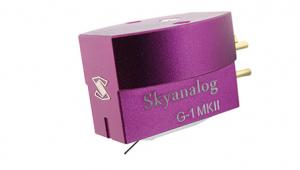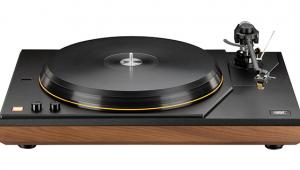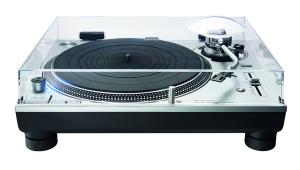Soundsmith Sg 200 (£5200)
I can’t deny it. There is something highly evocative about a cartridge that glows in the dark. That’s right: two blue LEDs at the front of the Soundsmith cartridge light up to confirm its operational status. Just a gimmick? No, not really. You see, the Soundsmith is quite unlike any phono pick-up you’re likely to have come across. It’s not a moving coil, nor is it a moving magnetic/moving iron type. And, no, neither is it a powered cartridge like Audio Note’s IO Limited that employs electromagnets in its generator system.Known as the Strain Gauge cartridge ‘system’, the Soundsmith is one of a kind. Instead of inducing a signal voltage by relative motion between coils and magnets, the stylus/cantilever movement deflects two minute silicon strain gauge elements [see boxout, facing page]. Cartridges such as this are extremely rare, collectors of vintage pickups revering the Win Laboratories SDT-10 ‘semiconductor disc transducer’ dating from 1965 and also recalling fondly Panasonic’s subsequent strain gauge cartridges that were designed for CD-4 records. The Panasonics received their requisite current from an accompanying quadraphonic demodulator/preamp.
ENTRY LEVEL
Headed up by engineer and designer Peter Ledermann, The Soundsmith company of New York repairs and services those old Panasonic strain gauge models, as well as building and repairing pick-ups for owners of classic B&O decks of yesteryear. And in 2006 the company introduced its own Soundsmith Strain Gauge cartridge, which has been wooing vinyl lovers in high-end hi-fi circles ever since.
High-end? Oh yes, these hand built cartridges cost an absolute packet, this latest SG-200 version being Soundsmith’s ‘entry-level’ model bereft of preamp features. All Soundsmith Strain Gauge cartridges are identical, the various models/prices relating to the partnering preamp that provides current to the cartridge and a line output to your system’s amplifier.
Note that this is not a phono stage, the cartridge having a natural 6dB/octave roll-off. Pedants for accuracy will complain that the resultant output only approximates the RIAA curve, designer Peter Ledermann maintaining that our ears are considerably less sensitive to frequency response errors than to the distortions and phase shift aberrations that would result from employing correction filters.
Ledermann firmly believes that less is more in terms of signal path simplicity, while extolling the virtues of the Strain Gauge’s much reduced effective moving mass, higher resonant frequency and superior information retrieval.
For upper models incorporating
fully-featured preamplifiers – with LED readouts on the esoteric models of downforce, force balance per groove wall, and record eccentricity no less! – prices run well over ten figures. Indeed the cost of ownership seems astronomical until you consider the total offerings. Any top-flight MC is going to deserve an audiophile quality phono stage. With a model such as the SG-510 featuring remote volume/mute, four line inputs and a tape loop (£11,000) you can dispense with the preamp in your system as well as your phono stage.
More importantly, whichever luxurious cartridge you might choose, its residual value will reduce by up to 70% during the three years or so during which you wear out its stylus. So unless you rarely play records – in which case why even consider such profligacy? – it will need trading in for re-tipping. Owning an esoteric cartridge is an expensive luxury for sure.
Crucially the Soundsmith Strain Gauge cartridge has a replaceable stylus, reducing immensely the running costs. Soundsmith’s replacement styli are available at just £150 for a bonded Shibata tip on an aluminium cantilever, £200 for a nude elliptical stylus, and £400 for a nude contact line profile with ruby cantilever.
Artisan Audio, the UK distributor, has elected that the SG-200 come fitted with Soundsmith’s top-of-the-range stylus as standard, something it calls its ‘optimised contour’ contact line with ruby cantilever which costs £500 to replace. Soundsmith can also supply specialist styli for 78rpm and vintage discs at £200.
Having a stylus that is easily removed and replaced in a matter of seconds to avoid accidents makes installing the cartridge a breeze, as do the threaded holes in the aluminium body. Note, however, that the weight of the Soundsmith is nearly 10g, so depending on your tonearm you might require an extra heavy counterweight.
.
FASTEN YOUR SEATBELTS
Within two or three hours my living room looked like it had been hit by a whirlwind as record sleeves lay strewn all across the carpet. From the instant the stylus hit the LP there was an immediacy and forthright delivery of the music that I thought reminiscent of ‘positive scanning’ Decca pick-ups. The speed and agility, especially in the way the Soundsmith delivers bass information, are nothing short of thrilling.
As most Decca-philes surely appreciate, while it sounds fast and vivid it can sound over-exuberant. I used various Deccas for several years and was always aware of their tendency to edginess on ‘hot’ recordings. Not so this Soundsmith, which delivers electrifying speed and dynamics Decca-style, while simultaneously never sounding anything other than liquid and refined.
The title track that opens Miles Davis’ Tutu album [Warner 925 490-1] has a blistering, difficult-to-keep-couth sound that the Strain Gauge transducer delivered majestically, keeping collaborator Marcus Miller’s stark, steely bursts of electronic synth sounds all of a piece and layered within the image. It’s impossible for any of us to know what this LP truly should sound like such is the electronic treatment used to create the sound image, but I know that I’ve never heard it quite like this. The dominant, persuasive bass notes added powerful union to the percussion while Davis’ potent trumpet bursts created an impression of ‘being there’… despite there being no ‘there’ to begin with.
Listening in true ‘studio monitoring’ fashion through a pair of mammoth active ATCs currently in residence, ‘Tutu’ sounded mighty blistering alright. It was not without the familiar ‘electronic edge’ in the recording that I’ve always assumed to be a case of mid-’80s studio ‘digititus’, however the vivid ‘blast’ of sound sculpture was delivered with unflustered finesse.
TONE AND TEXTURE
Moving to Talk Talk’s The Colour Of Spring [EMI EMC 3506], which I’ve been playing regularly during recent months as various analogue playback components have passed through my system, highlighted vividly the SG-200’s ability to describe bass tonality and texture. The switch from the visceral electronic bass of ‘Tutu’ to the rosy acoustic bass of Danny Thompson was painted in sharp relief by the Soundsmith.
It was the manner in which the tonality and texture was so succinctly etched that emphasised the cartridge’s ability to dig every little detail possible from the groove. ‘Happiness Is Easy’ sounded as dramatic and powerful as I believe I’ve ever heard it, while even the more compressed ‘Life’s What You Make It’, Talk Talk’s hit single from the album, was uncommonly open and clear. The over-complex production with organ, mellotron and piano buried alongside the thumping rhythm and soaring guitar seemed less ‘problematic’ as it avoided its familiar hardening.
Such was the desire to observe further how this transducer was revealing information that I dug out Bill Bruford’s Gradually Going Tornado LP to observe Jeff Berlin’s distinctive bass playing [EG Records EGLP 104]. Okay, the Soundsmith couldn’t disguise the poor fidelity of this late 1970s recording, but the micro-detailing of (the other) Dave Stewart’s keyboard arrangements were revelatory nonetheless. And the characteristic stabbing, staccato bass of Jeff Berlin was again visceral and infectious.
SENSE OF OCCASION
Audiophile reference LPs didn’t disappoint. Interestingly, with both my Townshend speaker system (which sounds both sweet and lush) and the active ATC (which is more up-front and uncompromising in its delivery), Reference Recording’s direct-to-two-track recording of the London Philharmonic Orchestra’s Arnold Overtures [Reference RR-48] was less ‘brightly-lit’ than I would usually describe it.
With the Soundsmith it sounded warmer and more full-bodied than usual, despite the brass and percussion cutting through with plenty of honk and realistic sizzle. Despite its ‘speed’ the Soundsmith delivers analogue ‘warmth’ and charm in spades. I thought that oft-used cliché ‘the silky sheen of strings’ has never been as apt as I allowed my imagination to transport me to the middle stalls of Watford Town Hall, sitting in front of the LPO two decades ago.
Album after album, the powerful immediacy and wonderfully descriptive ability of the Soundsmith made playing long forgotten records a sense of occasion. Were I in the market to invest in a cartridge for life, this would probably be it.
VERDICT
Clearly the price ticket will preclude ownership for many audio enthusiasts. Nevertheless when you consider the low running cost – the fact that you’ll likely own it forever thanks to its replaceable stylus – all vinyl aficionados with high-end systems owe it to themselves to hear this thrilling cartridge. Just be warned that living with the Soundsmith Strain Gauge will only lead to many foolishly late nights.
Sound Quality: 87%
Originally published in the May 2010 issue



















































